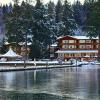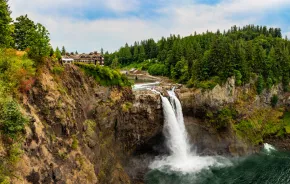Beachcombing, kid-friendly hiking and exploration, unusual accommodations and a history that stretches back to the Lewis and Clark expedition: Cape Disappointment State Park (formerly Fort Canby), located on southwestern Washington coast, has it all. Throw in breathtaking ocean vistas and you have a prime destination for mildly adventurous travel, family style, that won't break the bank and is close enough for a weekend trip.
The park encompasses miles of beach and hiking trails, and high cliffs -- accessible by trails -- where visitors can take in huge views of the Pacific Ocean and the Columbia River. Forested lands here are a deep, lush green, offer frequent glimpses of deer and many bird species, and often contain surprises from the park's military past -- it served as a fort up until the end of World War II.
The McKenzie trail starts off as a hike through a primeval-looking forest full of ferns and mosses, and then becomes quite steep. It ends quickly at what you soon realize is a cliff, called McKenzie Head, that once was the location of Gun Emplacement Battery 247. A large, circular concrete pit that acted as a base for the gun is still there, now filled with water and growing weeds from its center. It's become a pond, and in spring the water is filled with tadpoles. Next to it, a concrete structure -- pitch-black inside -- invites exploration. The mysterious air of abandoned civilization makes this place ready-made for games of the imagination.
The whitewashed 1898 North Head Lighthouse, located a short distance by car from the campgrounds and accessible by a flat, easy trail that begins near the parking lot, sits on a high bluff (called North Head) with more spectacular views of beach, campgrounds and ocean. The lighthouse is no longer in service and the site, which can be extremely windy, is a fine place for exploration and circular games of chase around the building. Tours, with hours that vary by season, are also available for $1 per person.
Near the park's entrance lies Waikiki Beach, the only beach where swimming is considered safe. It's a relatively protected cove, flanked by a steep cliff on one side, that's filled with driftwood and perfect for beach-going with small children. Benson Beach, which can be accessed by foot from the park's campsites, is much longer and wilder. It's guarded by North Head on one side and patrolled by endless streams of birds flying over the water parallel to the shore, including enormous flocks of low-flying pelicans.
Cape Disappointment is the spot where the Lewis and Clark expedition finally reached the mouth of the Columbia River and the Pacific Ocean via Waikiki Beach. The Lewis and Clark Interpretive Center, located on a 200-foot bluff within the park, is a good place to go for an overview of the expedition's trip from St. Louis to Washington state. The trail from the parking lot to the interpretive center passes another gun battery known as Battery Harvey Allen. Kids (and many adults) are irresistibly drawn to explore the battery's rooms and hiding places. The interpretive center is open daily, 10 a.m.-5 p.m.; admission is $3 for adults and $1 for children ages 7 to 17.
One of the park's chief charms is its stock of 10 yurts, which are available year-round for $40 per night. These round, permanent canvas structures with floors, windows, furniture, heat and electricity, sleep four and give visitors a taste of camping (you still have to cook outdoors) without some of its less appealing aspects.
Inside, you'll find bunk beds, a queen-sized futon and enough floor space to comfortably sit inside and play games on a rainy day, which, even during summer, is a possibility due to changeable coastal weather. Outside, a partially covered deck also protects from the weather, and a picnic table and fire pit sit on a concrete pad.
During peak season and on weekends, the yurts are popular: Plan well ahead if you want one, or make plans for the off-season. Yurts and regular campsites are located on small paved cul-de-sacs where children ride bikes or scooters; camping here is more of a communal than private experience. The yurts are wheelchair-accessible, and the park features two ADA-compliant restrooms and four ADA-compliant showers.
If even semi-camping is roughing it too much, three red-roofed lightkeepers' residences, located near North Head Lighthouse with ocean views, are also available for vacationers to rent. Each residence sleeps six and has one bath, full kitchen, linens, TV and VCR. During the off-season, from Nov. 1-May 14, the residences rent for $183-$259 plus tax per night on Friday through Sunday, with discounts during the week. During peak season, May 15-Oct. 31, rentals are $244-$345 per night, plus tax. Call 1-888-CAMPOUT or visit www.parks.wa.gov for campsite, yurt and residence reservations.
There's plenty to do at Cape Disappointment, from exploring its habitats to bicycling its roads to attending ranger-led interpretive programs. Yurts make camping a bit easier on families with small children. And regardless of the accommodations you choose, you'll fall asleep to the sound of the ocean.
Kris Collingridge is Out & About editor at ParentMap and a convert to yurt camping.
Cape Disappointment Side Trips
Nearby Long Beach, with its 28 miles of driveable beach, offers go-karts and other amusements downtown, as well as a full calendar of events, the World Kite Museum and Hall of Fame (www.worldkitemuseum.com), and Marsh's Free Museum, known to regular visitors as the home of Jake the Alligator Boy (www.marshsfreemuseum.com).
If you visit during August, make time for the Washington State International Kite Festival. Go to www.funbeach.com for exhaustive information about goings-on in Long Beach and surrounding areas.
Astoria, Ore., is located about 20 miles from Long Beach across the 4.1-mile Astoria Bridge, which spans the Columbia River. Walk the streets of a funky downtown that retains the flavor of past eras, and leave time for a trip to the town's signature Astoria Column, located atop the highest hill in town. Climb its 164 steps for splendid 360-degree views of the town and its Victorian houses, the ocean, the Columbia and the surrounding countryside, including Mt. St. Helens. Picnic tables are located on a steep, grassy hillside, where you can eat and gaze down at the scene below. For more activity suggestions, visit www.astoria-usa.com











